The Intricacies of Tektites: Nature's Mysterious Glass
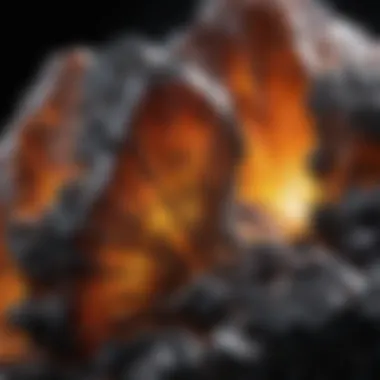
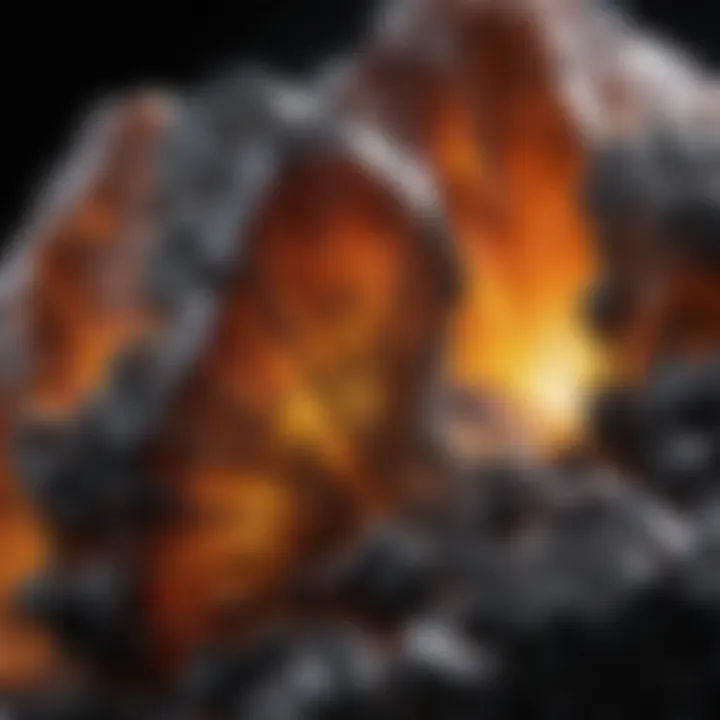
Intro
Tektites are a distinctive phenomenon, stemming from high-energy extraterrestrial impacts that have resulted in the formation of unique glass-like substances. These intriguing objects bite into the fabric of both geology and gemology, compelling researchers and enthusiasts alike to unravel their secrets. Tektites not only spark curiosity due to their unique origins but also serve as a bridge linking our terrestrial understanding with cosmic forces. This article will cover the various dimensions of tektites, revealing their significance across different spheres, from geology to metaphysics.
Gemstone Overview
Definition and Origins
Tektites are natural glass formed by the intense heat and pressure generated during catastrophic meteoric impacts. They are typically found in strewn fields, scattering across vast geographical areas. The term 'tektite' itself derives from the Greek word "tektos," meaning molten. These objects are often characterized by their dark color, glassy texture, and distinct shapes.
The creation of tektites involves the vaporization and melting of the earth’s material at impact sites, followed by rapid cooling. The resulting mass can be ejected into the atmosphere, ultimately falling back to the Earth’s surface as these striking artifacts. To put it simply, tektites are nature’s glass, sculpted into form by the fierce embrace of cosmic events.
Historical Significance
Throughout history, tektites have intrigued cultures around the globe. They have been mistaken for various substances, from meteorites to sacred stones. In some ancient civilizations, these mysterious remnants were often regarded with reverence, believed to hold metaphysical properties.
For instance, in Vietnam, the famous "Moldavite" tektites have been integrated into local folklore as symbols of transformation and protection. Additionally, tektites have played a role in scientific studies, shedding light on Earth’s geological history and the impacts of celestial bodies.
"Tektites are a testament to the chaotic nature of our universe, reminding us of the ever-changing dance between Earth and the cosmos."
Gemstone Properties
Hardness and Durability
Tektites are typically classified along the Mohs scale, with a hardness of about 5.5 to 6.0. This places them in a category where they are relatively durable, making them suitable for various types of jewelry. However, they can be prone to scratches, so care should be taken when handling and wearing pieces containing these materials.
Color and Clarity
The variety in color found among tektites is quite striking. Most take on dark hues, ranging from deep olive green to black, but can also be found in shades of brown and even translucent variants. The clarity of tektites can vary significantly; some may exhibit gas bubbles or internal inclusions, contributing to their uniqueness and desirability for collectors.
Understanding Tektites
Tektites represent an intriguing blend of science and mystery, capturing the attention of gem enthusiasts, geologists, and curious minds alike. They exemplify the forces of nature at play, borne from meteoric impacts that mold glassy formations scattered across the globe. Understanding tektites is paramount as it sheds light on not only their formation but also their significance in the broader context of geological history and human culture.
Definition and Origin
The term "tektite" comes from the Greek word "tektos," which means molten. Put simply, tektites are natural glass that result from high-energy events. Their origins are commonly traced back to major meteorite impacts, where terrestrial materials turn into glass due to the intense heat and pressure. This extreme transformation ends up creating these fascinating spheres, discs, or irregular shapes found in varying colors and sizes. The most notable types include the Libyan Desert Glass and the Indochinites. The fascination with tektites mainly stems from their extraterrestrial connection, with many enthusiasts eager to explore their place in Earth's geological narrative.
Formation Processes
Tektites can be formed through two primary processes: extraterrestrial impact events and terrestrial processes. Both avenues contribute unique insights into the characteristics of these natural glasses.
Extraterrestrial Impact Events
Extraterrestrial impact events are a cornerstone of tektite formation. When a meteorite collides with Earth, the impact releases an immeasurable amount of energy, causing the surrounding materials to vaporize and subsequently condense into droplets of glass. This process results in tektites being scattered over extensive areas, sometimes covering hundreds of kilometers from the impact site.
- Key Characteristic: Tektites formed from such impacts often exhibit a distinctive aerodynamic shape, molded by the intense heat and rapid cooling that occurs shortly after their formation.
- Benefits: Understanding the genesis of these tektites offers valuable clues regarding impact history and planetary collisions, allowing researchers to piece together Earth’s tumultuous past. These insights can then inform broader studies on the evolution of the planet and its atmosphere.
- Unique Feature: One of the chief advantages of studying tektites from impact events is their correlation to events that can be traced through geological time. They serve as indicators for significant changes on Earth, akin to nature’s historical markers.
Terrestrial Processes
Terrestrial processes also contribute to the formation of tektites, though to a lesser extent compared to those resulting from impacts. These processes generally encompass volcanic activity and intense geothermal events, where silica-rich rocks undergo melting under extreme heat.
- Key Characteristic: Unlike their impact-derived counterparts, tektites formed through terrestrial processes may not show the same aerodynamic shapes and can vary widely in texture and color, leading to a diverse range of glass forms.
- Benefits: This variety allows for a broader understanding of different geological processes and helps to assess the environments that yielded such glassy formations. For those in geology, this can spark new discussions about the cycles of rock formation and alteration.
- Unique Feature: One advantage of examining tektites from terrestrial processes is that they can illustrate more recent geological activities and local conditions that may have gone undocumented, providing contemporary insights into Earth’s dynamic system.
Overall, understanding tektites through their definition, origin, and formation processes not only enriches scientific knowledge but also enhances their allure in the eyes of collectors and enthusiasts. These glasses represent the intertwining of cosmic and terrestrial events, reminding us of the delicate balance in our planet's history.
Chemical Composition of Tektites
The chemical composition of tektites serves as a lens through which we can better understand the mechanisms behind their formation and their place within geological studies. Tektites are primarily composed of silicate glass, a fact that underscores their extraterrestrial origins. But what truly sets tektites apart is not just their primary structure—it's the diversity of elements and isotopes that vary across different types of tektites. This variation holds key insights into the impact events that created these exquisite materials.
Silicate Glass Structure
The silicate glass structure identifies tektites as a type of glass not formed through the typical baking of silica in a kiln, but rather through the intense pressure and heat generated during impact events. In simple terms, when a meteorite strikes the Earth, the molten material can be ejected, cooling rapidly to create the glassy substance we call tektites. This structure not only grants them their shimmering appearances and unique forms but also affects their physical properties—including durability and refractive index.
The silicate glass of tektites is predominantly made up of silicon dioxide (SiO2), but its structure often includes other oxides like aluminum (Al2O3) and magnesium oxide (MgO). For anyone delving into this realm, understanding this framework helps outline why different tektites exhibit varied hardness and brilliance, making each piece a story of its cosmic journey.
Trace Elements and Variations
Tektites are also defined by their trace elements, a topic that enriches the conversation about their geochemistry and formation.
Common Chemical Elements
Tektites contain a variety of common chemical elements, such as:
- Silicon
- Oxygen
- Aluminum
- Iron
These elements play a crucial role in the physical characteristics of tektites. For example, high levels of iron not only increase their density but may also affect their color, turning them into deep greens or blacks. This adaptability makes tektites a popular choice for collectors and enthusiasts, as each stone's elemental makeup contributes to its visual charm and narrative.
A unique feature of these common elements is their varying proportions across different tektite varieties. This in turn shapes everything from appearance to how they are valued in gemology. Different combinations of these elements can lead to differences in hardness or transparency, which in turn influences their application in jewelry making.
Geochemical Significance
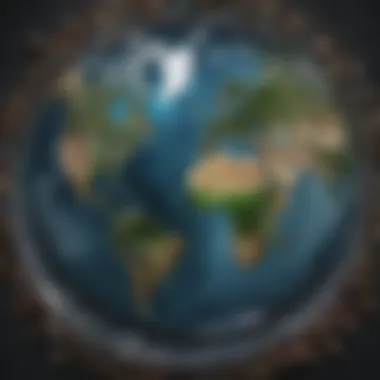

Examining the geochemical significance of tektites is vital for both collectors and scientists alike. For instance, the presence of trace elements like titanium or zirconium can suggest the specific conditions these substances were subjected to during formation, including temperature and impact energy. These factors can indicate how near or far the tektite is from its original impact zone—a factor of interest for serious geology enthusiasts.
As collectors dig deeper into the allure of these natural treasures, the geochemical composition adds a layer of beauty beyond aesthetics. It allows enthusiasts to trace back the history of each piece, making the act of collecting not just acquisition but also a voyage through time.
"Tektites form a bridge between the Earth and outer space, hinting at past cosmic events while captivating those who seek to discover their secrets."
Overall, a tektite's chemical makeup can provide significant insights, not only into its beauty and functionality in jewelry but also into larger questions about planetary geology and cosmic history. Understanding these compositions offers a layered appreciation for these spatial artifacts, making them all the more fascinating for collectors and enthusiasts.
Geographic Distribution
Understanding the geographic distribution of tektites is essential in grasping their formation, properties, and significance. Different strewn fields and occurrences can illuminate not only the chemical variations of these glassy relics but also provide insights into the impact events that created them. The regions where these tektites are found can be key indicators of past geological activity, offering windows into Earth's history.
Specific locations harbor unique tektite forms, shaped by the very conditions under which they were formed. Notably, where one might stumble upon a gleaming piece of tektite, the story woven into that glass can reveal much about the planet’s interactions with cosmic forces.
With that in mind, let’s delve into some of the notable tektite strewn fields that showcase the fascinating diversity and significance of these natural phenomena.
Notable Tektite Strewn Fields
Libyan Desert Glass
The Libyan Desert Glass, also known as "Great Sand Sea glass", stretches across a swath of the Sahara Desert. This tektite is renowned for its captivating gold to greenish hue, making it a highly sought-after specimen in both gemology and science alike. Its beauty lies not only in its color but also in its translucence, rendering it a remarkable choice for jewelers and collectors.
Key characteristics include:
- Color and Transparency: The glass can exhibit a stunning range of colors, often appearing like liquid gold under certain lighting.
- Formation Process: Research suggests its formation came from an ancient meteorite impact, which melted the silica-rich sand and resulted in the creation of this tektite.
- Benefits in Jewelry: The unique aesthetic quality of Libyan Desert Glass leads to its popularity in high-end jewelry design, making it a prized addition to any collection.
A unique feature to note about Libyan Desert Glass is its relatively low density compared to other glassy materials. This can be advantageous when used in intricate jewelry settings. However, its rarity can also be a disadvantage, as it can command a premium price in the market.
Indochinese Tektites
In contrast, Indochinese Tektites, found across parts of Southeast Asia, particularly in Vietnam, Laos, and Thailand, contribute a different narrative to the story of tektites. Their distinctive shape, often resembling highly polished blobs or elongated forms, adds intrigue to their collection.
Key characteristics include:
- Diversity in Shapes: They can come in various shapes, from teardrop to disc-like formations, often facilitating a broader appeal among collectors.
- Historical Significance: The widespread occurrence of these tektites suggests a massive impact event, possibly linked to a meteorite entering Earth’s atmosphere.
- Jewelry Use: While they are not as visually radiant as Libyan Desert Glass, Indochinese Tektites hold their own niche in jewelry, often appreciated for their raw and natural forms.
A unique aspect of Indochinese Tektites is their extensive distribution across multiple countries, which can complicate provenance and valuation, making them both accessible yet challenging for collectors seeking authenticity.
Global Occurrences and Implications
The presence of tektites worldwide indicates a rich history of impact events that have shaped not only the geological landscape but also human culture. Each location delivers insights into the planet's past, reflecting the cosmic dance between Earth and celestial objects.
Tektites can serve as markers of geological processes and climatic conditions. Their study can lead to greater understanding of how our planet has evolved over time.
"Tektites are not only scientific curiosities; they symbolize the very fabric of our planet's history and the elements that shaped it."
Properties of Tektites
Understanding the properties of tektites is like peeling back the layers of an onion; each aspect reveals more about these fascinating natural glasses formed by high-energy impacts. The properties serve as keystones in comprehending not just how they formed, but also their significance in both geological and gemological contexts. By examining the physical properties such as transparency, luster, density, and hardness, along with the gemological characteristics, one can appreciate tektites not just as scientific curiosities but also as exquisite materials that bridge nature and artistic expression.
Physical Properties
Transparency and Luster
One standout characteristic of tektites is their remarkable transparency and luster. These features contribute significantly to the overall aesthetic appeal of tektites, making them desirable for collectors and jewelry makers. Tektites often exhibit a glass-like sheen that can range from transparent to translucent. This quality allows light to dance through the material, creating visual effects that are quite striking.
A key aspect of clarity is that it can enhance the perceived value of the piece. Tektites with high transparency are more sought after for jewelry creation since they allow for unique light reflections. However, it wouldn't be fair to ignore the unique feature of some tektites that have a more opaque appearance, which can also tell tales of their complex formation processes.
“The luster of tektites can be so intense, it almost feels like holding a piece of the stars.”
In terms of disadvantages, the fragility associated with transparency can play a role. While they may be visually appealing, tektites can be prone to chipping or cracking if not handled with care. Thus, understanding both the aesthetic benefits and potential downsides is essential for both enthusiasts and jewelers.
Density and Hardness
When discussing density and hardness, one discovers that these minerals have a sturdy edifice despite their delicate appearance. The typical density of tektites ranges from 2.2 to 2.5 g/cm³, a feature that speaks volumes about their resilience. With a hardness level of around 5.5 on the Mohs scale, tektites offer a certain robustness that makes them suited for various applications, be it in jewelry or scientific study.
The density allows manufacturers to appreciate the feel of tektites compared to other gemstones. The heftiness adds a tangible value, enhancing their wearability in jewelry. Collectors often seek out pieces with specific densities, linking them to their origin and formation conditions. However, the hardness does raise some considerations when it comes to cutting and polishing since the materials do require specialized techniques.
A unique feature of tektites is their ability to withstand scratches from everyday wear while adding an air of mystery through their robust nature. Yet, there is a thin line between being resilient and being difficult to work with during the crafting process.
Gemological Characteristics
Shifting to gemological characteristics, tektites exhibit distinct qualities that make them stand out in the gem world. Beyond the physical properties, factors like color and surface texture also play crucial roles in determining the value and appeal of tektites. Different tektite varieties may display hues that range from deep green to almost black, depending on their chemical composition and formation processes.
The textures can also vary, showing smooth surfaces or unique pitted patterns that tell their story of having been formed through extreme heat and stress. These characteristics enhance the allure of tektites, attracting those who appreciate not only beauty but also the backstory behind each piece.
It's important for gemological assessments to consider these factors carefully. Whether one is a collector looking for a unique specimen or a jeweler seeking exceptional beauty, understanding gemological characteristics can offer insights into the narrative and value of each piece.
Classification of Tektites
Understanding the classification of tektites brings a variety of benefits. It not only helps in identifying the different types and their origins but also sheds light on the conditions that lead to their formation. Knowledge of classification is crucial for gemology, geology, and collectors. Differentiating these natural glass fragments allows researchers to draw conclusions about Earth's history and the dynamics of past impact events while also enhancing the appreciation for these unique specimens among enthusiasts.
Types of Tektites
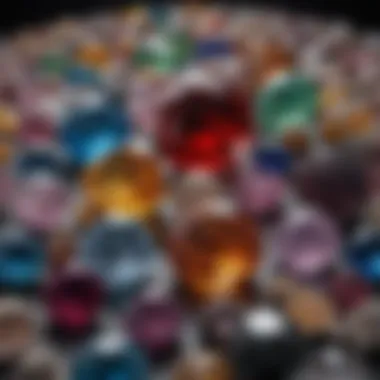

Stishovites
Stishovites are a rare type of tektite that provide insights into extreme pressure conditions. Specifically, they are formed when silica undergoes violent compression during high-energy impact events. The most distinctive feature is their unique crystal structure, which can be identified by their rectangular-shaped crystals. This specific aspect contributes to the overall understanding of impact lithologies. Stishovites can be a popular choice amongst collectors due to their rarity and beauty, appealing to those who admire unique geological specimens.
However, stishovites come with certain disadvantages. Their formation process is so intense and specific that findings are uncommon. Collectors might find them in limited locations, which could make them quite expensive. Nonetheless, their unique characteristics and limited availability mark stishovites as notable artifacts in the study of geological impacts.
Coesite
On the other hand, coesite is another fascinating variant within the tektite classification. Its formation is linked to extremely high-pressure environments, often five times that of standard atmospheric pressure. Coesite is recognized by its distinctive glassy appearance and is often less crystalline than its cousin, stishovite. This particular property makes coesite an excellent subject for geological research, as it helps to reveal the processes involved in high-pressure metamorphism.
Collectors may find coesite particularly appealing due to its aesthetic qualities and its scientific significance. However, it may not be as readily available as one might hope, which can limit access for some enthusiasts. Still, those who can acquire it often consider it an invaluable addition to their mineral collection.
Physical Classification Systems
Physical classification systems help in organizing tektites into coherent categories based on observable characteristics. These systems enable scientists and collectors to identify and compare samples effectively. Key elements in these systems include size, color, surface texture, and internal structures. Utilizing such a classification, one might typically encounter:
- Size: Tektites can range from tiny grains to larger fragments, which can influence their market value.
- Color: The coloration—be it black, green, or brown—often adds aesthetic appeal, affecting the demand in the gem market.
- Surface Texture: Some may exhibit pitting or smoothness, resulting from their formation processes.
Understanding these classifications not only facilitates academic discussions but also enriches the appreciation for tektites among those who delve into this captivating field.
Tektites in Geology
Tektites serve as a valuable resource in geology, acting as clues that help scientists piece together Earth's dynamic history. Their formation and distribution tell a compelling story about the impact events that have shaped our planet. By examining these natural glasses, we can glean insights into the forces that not only create them but also influence our Earth's geological narrative.
Role in Impact Studies
Understanding tektites is crucial for impact studies, which focus on the effects of celestial collisions with Earth. Each tektite, with its unique characteristics, can provide critical data about the energy and processes involved during such events. The blast from an extraterrestrial impact can cause rocks to melt and vaporize, leading to the formation of tektites. Their composition sometimes mirrors that of the parent material from which they originated, allowing geologists to reconstruct the type and scale of the impacts.
The study of tektites can help determine:
- Impact Energy: The structure and distribution can give scientists insights into the energy released during the impact.
- Parent Body Material: Analyzing the chemical signature of tektites can reveal information about the meteorite or object that struck Earth.
- Environmental Effects: They hint at the aftermath of impacts, providing data about climate changes that might have followed such events.
This research is instrumental in understanding not just tektites themselves, but also the broader implications of impacts on biological evolution and geology. Further research initiatives continue to shed light on the profound implications these little pieces of glass bear.
Understanding Earth's History
Tektites capture chapters of Earth's history that might otherwise remain hidden. They offer a window into the planet's past events, showcasing the forces that have molded continents, shaped landscapes and potentially influenced life.
The study of these objects can lead to discovery in various aspects:
- Chronological Events: Each strewn field of tektites can be connected to specific impact events, allowing geologists to date these occurrences with greater precision. This correlation is invaluable for constructing timelines of Earth's environmental conditions.
- Climatic Shifts: The debris from impacts might kick up particles that alter climate patterns, affecting everything from temperature to atmospheric composition. Studying tektites helps trace these climatic shifts.
Tektites are like nature's diary; every glassy piece holds a story of cosmic encounters and geological transformations.
The significance of tektites in understanding Earth's geological history cannot be overstated. They are not merely curiosities; their study can unlock knowledge about ancient environments and the complex interactions between celestial bodies and our planet. By piecing these fragments together, scientists are able to construct a richer understanding of Earth’s rich tapestry of history.
Tektites in Gemology and Jewelry
When we think about gemstones, many people's minds immediately jump to the likes of diamonds, sapphires, or emeralds. However, tektites offer a compelling case for their inclusion in the world of gemology. Their unique origins and stunning glass-like appearance capture the imaginations of gemstone enthusiasts and collectors alike. These natural glasses, formed through extraordinary extraterrestrial or terrestrial processes, carry stories from the cosmos and the Earth’s surface, making them not only visually stunning but also historically significant.
Tektites as Fashionable Gems
In recent years, tektites have gained traction as fashionable gems in the jewelry world. The organic allure of these pieces stems from their varied textures and colors, often resembling a beautiful mix of earthy tones and glistening surfaces. Many jewelers have embraced tektites for their unconventional charm, attracting those who seek to step away from mainstream jewelry trends.
Notably, a particular type known as Libyan Desert Glass (also called "golden tektite") showcases an array of yellows and golds that add a touch of glamour and uniqueness. The rarity and natural beauty of tektites can elevate a simple piece of jewelry into something strikingly unique. Given their offbeat background, wearing tektites can be a conversation starter, inviting curiosity and admiration.
Lapidary Techniques
Cutting and Polishing
When it comes to working with tektites, cutting and polishing these enigmatic gems requires a skilled hand. The process begins with careful planning; since tektites are primarily glass, they can be tricky to shape without chipping or cracking. Jewelers often opt for techniques that preserve the natural beauty of the tektite while enhancing its luster.
The key characteristic of cutting tektites lies in the decision to leave some areas rough, providing an organic feel to the final product. Many jewelry designers appreciate this approach as it maintains the gem's authenticity and raw allure. However, precise polishing techniques help achieve a smooth finish, reflecting light brilliantly, which is a beneficial choice for those wanting to accentuate the inherent beauty of a tektite.
Though the advantage of this meticulous approach results in stunning pieces, it requires patience and skills that not all lapidaries possess. The main disadvantage often comes from the risk of damaging the stone during refinement, a constant concern for jewelers.
Setting Tektites in Jewelry
Once tektites have been beautifully cut and polished, the next step is knowing how to set them into jewelry effectively. This aspect can make or break the overall appearance of the piece. Designers often choose minimalist settings to spotlight the tektite's unique features, favoring designs that allow light to flow unhindered through the glass.
One noteworthy characteristic is that tektites can be set in either traditional metals like silver or gold, or even more contemporary materials like titanium. This versatility makes them a popular choice for jewelry-makers. Incorporating a tektite into a setting not only elevates the gemstone's beauty but also enhances the wearer’s connection to the Earth and cosmic history.
However, a significant consideration in setting tektites is the need for secure mounting given their comparative fragility. Jewelers must balance style and security for pieces meant to be worn regularly.
"Every tektite has its own story embedded within, connecting us to cosmic events that shaped our planet."
The integration of tektites in gemology and jewelry highlights a blend of craftsmanship and nature, broadening the horizon for both gem enthusiasts and casual wearers. With careful consideration in both cutting and setting, tektites can transform into exceptional statements of personal style and historical significance.
Metaphysical Properties of Tektites
Tektites are more than mere geological curiosities; their metaphysical properties hold a prominent place in various cultural beliefs and practices. Understanding these properties opens a window into how people perceive these stunning natural formations. For gemstone enthusiasts and collectors, tektites' allure extends beyond their appearance into the realm of healing and spiritual significance.
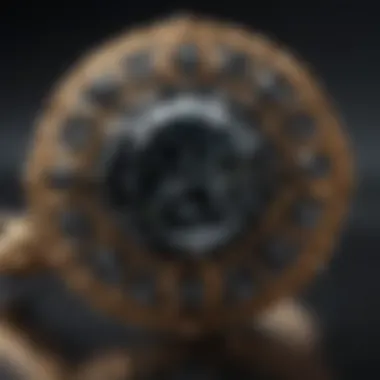
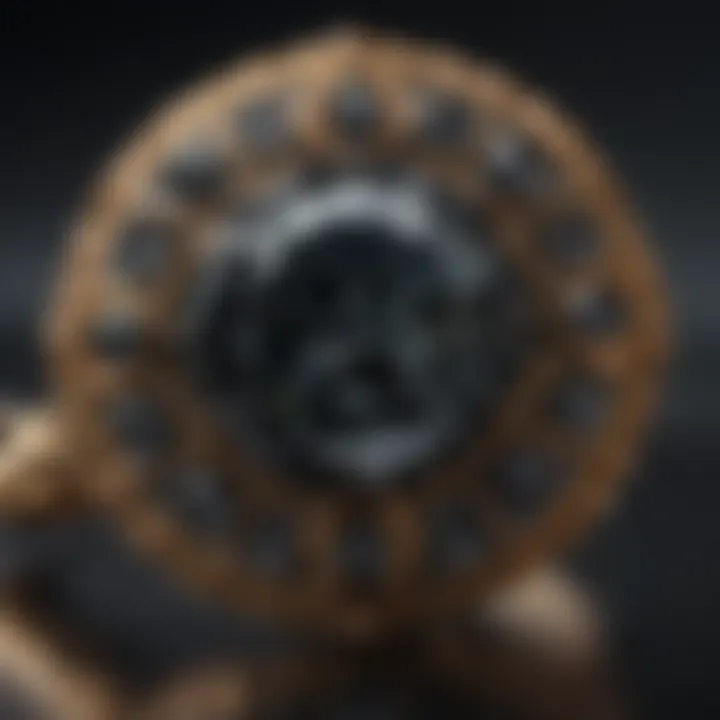
Healing Attributes
Tektites are often thought to carry unique healing energies. Many believe they can help in the pursuit of emotional balance. The smooth surface and distinct shapes of tektites provide a calming presence, making them popular among those practicing meditation and energy healing. Users often report a sense of tranquility or release when holding or meditating with these stones.
Some specific benefits attributed to tektites include:
- Emotional Release: Tektites are believed to assist in unearthing hidden emotions, allowing for catharsis and healing.
- Grounding Energy: Many practitioners say tektites foster a deep-rooted connection to the Earth, promoting stability during tumultuous times.
- Enhanced Intuition: It’s said that these shards of cosmic energy help sharpen one’s intuition, leading to better decision-making and self-awareness.
However, it's important to approach the use of tektites with an understanding that personal experience varies widely. They might resonate differently with individuals and should be treated as personal tools rather than universal cures.
Spiritual Significance
When exploring the spiritual side of tektites, one cannot overlook their connections to the cosmos. Derived from extraterrestrial impacts, they symbolize a bridge between Earth and the universe. Many view tektites as conduits for cosmic energy, acting as reminders of one’s original connection to the stars.
Some cultures even regard these glassy forms as instruments for spiritual growth, encouraging users to explore deeper aspects of their consciousness. Here's what some enthusiasts believe about their spiritual importance:
- Transformation: The very nature of tektites, formed under intense heat and pressure, is seen as a metaphor for transformation. They inspire one to embrace change and evolution in their own lives.
- Protection: Some people carry or wear tektites as talismans for protection against negative energies or influences. This reflects a desire for inner strength and fortitude in challenging situations.
- Connection to Higher Realms: Tektites are often viewed as gateways to higher realms of consciousness, making them favored choices for shamanic practices or spiritual rituals.
"Tektites serve not just as beautiful curiosities but also as artifacts that speak to our very connection with the universe, mirroring our own journeys of transformation."
In summary, the metaphysical properties of tektites encapsulate a rich tapestry of beliefs related to healing and spirituality. As their narrative unfolds, tektites stand at the intersection of nature and the unseen, drawing everyone from collectors to spiritual seekers into their enigmatic embrace. By delving into these aspects of tektites, enthusiasts can appreciate not only their physical beauty but also the powerful energetic signatures they are believed to carry.
Cultural and Historical Significance
The cultural and historical significance of tektites cannot be overlooked, as these fascinating geological artifacts weave their way through the tapestry of human history and belief. Tektites not only embody natural history but also reflect the creativity and spirituality of ancient civilizations. Their unique origins and properties have led to a variety of interpretations and uses across different cultures, illustrating how nature's wonders can be interwoven with human experience.
Tektites in Ancient Civilizations
In ancient times, tektites were often shrouded in mystery and enchantment. For example, the Libyan Desert Glass was held in high regard by ancient Egyptians, who believed it came from the gods. This believed connection to the divine made tektites a sought-after material for amulets and jewelry. They were often used in ceremonial contexts, perceived as protecting the wearer or conveying spiritual power.
Archaeological findings suggest that ancient Mesopotamians also valued this glassy substance. They used it to craft tools and sculptures, displaying their craftsmanship while harnessing what they regarded as a celestial gift. Such artifacts provide us a glimpse into how ancient societies interacted with the natural world, attributing significance to materials they did not yet fully understand.
Moreover, the use of these objects in burial practices further emphasizes their importance. Tektites were often placed in tombs, signifying their role not just as decor or gifts, but as essential components in the afterlife, believed to accompany the deceased into the next realm.
Current Cultural Associations
Fast forward to today, and tektites continue to hold a special place in modern culture. Their beauty and extraterrestrial origin captivate those exploring gemology and metaphysics. Many contemporary practitioners of spiritual and healing arts claim these gemstones can facilitate connectivity to otherworldly energies, making them popular in the wellness community.
Tektites are often linked to grounding and transformation. Practitioners use them in meditation, claiming they help individuals tap into their intuition and explore their subconscious. This association with spiritual awakening extends to jewelry design, where many artisans create pieces imbued with not just aesthetic appeal but also intended metaphysical benefits.
Additionally, there is a growing community of collectors who appreciate tektites for their uniqueness and rarity. With each piece telling a story of planetary collisions and geological wonders, enthusiasts find themselves drawn to these artifacts not just for their beauty but for the history they represent. Some collectors even engage with online platforms such as Reddit and Facebook to share knowledge and best practices regarding their collection, demonstrating a vibrant community that bridges science and personal passion.
"Tektites serve as a remarkable nexus between human history, natural science, and the intangible aspects of spirituality."
In summary, tektites hold a myriad of meanings across time and cultures, reflecting our ongoing quest for connection to the earth and the universe beyond. Their journey from ancient artifacts to modern symbols of spiritual exploration illustrates the profound impact these unique natural glasses have on humanity's collective experience.
Challenges in Tektite Research
The study of tektites presents a host of challenges that researchers grapple with, and understanding these hurdles is essential to unraveling the many mysteries surrounding these natural phenomena. As a unique form of glass formed from high-energy impacts, tektites hold a wealth of information about not only the conditions of their formation but also about Earth’s history. However, the intricacies of their research often frustrate even the most seasoned scientists.
Sourcing Authentic Samples
A significant challenge in tektite research revolves around the sourcing of authentic samples. With numerous kinds of glass that mimic the appearance of genuine tektites, old-time gem hunters can easily fumble the ball, mistaking ordinary glass for the real deal. Identifying true tektites requires acute observational skills, as analysts must be aware of the nuances in chemical composition and physical characteristics that distinguish authentic tektites from impostors.
Sourcing these samples often involves fieldwork in remote or hazardous locations. For instance, the Libyan Desert Glass is sought after for its exquisite beauty and rarity, yet trekking the desert sands isn’t exactly a breezy walk in the park. Additionally, the associated ecological and legal regulations in various regions may pose barriers to extraction.
Here’s where technology leaps to the forefront. Contemporary geochemistry techniques, such as laser ablation inductively coupled plasma mass spectrometry, have made it easier to differentiate tektite samples. Through this advanced technology, researchers can analyze isotopic signatures and elemental compositions, allowing them to accurately date and classify samples.
Uncertainties in Classification
The classification of tektites also presents uncertainties that can confound researchers. Historically, tektites have been grouped into various classes based on their geographical origin and physical traits. However, distinguishing one variety from another requires a thorough understanding of the subtle differences in properties.
For example, Indochinese tektites exhibit fine textures and are often dark in color, while Libyan Desert Glass is typically more translucent and can be golden in hue. The overlap in characteristics can lead to misclassification, especially when examining small or fragmented samples.
This confusion can extend into the purpose of tektites in geological research. While many scientists hope to draw parallels between meteorite impacts and contemporary geological phenomena, misidentification can result in erroneous assumptions about Earth’s history and the mechanics behind its geological transformations.
As the field continues to evolve, there’s a consistent push for standardization in classification methods. The integration of genetic and compositional data into a more robust classification system could pave the way for more reliable categorizations, aiding in both research and education about these remarkable natural glasses.
Understanding the challenges in tektite research not only sharpens our appreciation for these geological beauties but also sets the stage for richer, deeper insights into our planet's history.
Ending: The Intriguing World of Tektites
Tektites present an extraordinary intersection of natural history, chemistry, and even metaphysics. Their study embodies not just a quest for knowledge but a deeper appreciation for the dynamic processes that shape our planet. Understanding tektites is like peeling back the layers of an onion; each layer reveals something unique about both Earth and the cosmos.
The importance of this article lies in highlighting how tektites are more than just geological oddities. They serve as a record of impactful events, offering insights into the history of Earth and the cataclysmic forces that have shaped it. Their formation from literally out-of-this-world events connects us to the universe in ways that are hard to comprehend. This raw beauty of tektites allows them to bridge scientific inquiry with artistic expression, often finding their place in the jewelry of collectors and enthusiasts alike.
Moreover, tektites have implications that extend into various fields of study. From geology to gemology, the appreciation of these unique glass forms can ignite curiosity across disciplines. Collectors and investors often seek them out, not just for their aesthetic appeal, but for their scientific significance—making them a fascinating fusion of art and science. Understanding the talisman-style properties attributed to tektites can even engage those in metaphysical realms, prompting discussions about healing and personal growth.
"Tektites are a testament to the wonders of our Universe, reminding us that beauty often arises from chaos."
As we wrap up our exploration, it’s essential to recognize that the world of tektites is still wide open for investigation. Scholars, enthusiasts, and newcomers alike are encouraged to delve deeper into their mysteries. With ongoing advancements in analytical technologies and methodologies, future research could unveil even more about their origins, properties, and myriad uses.
Future Directions in Tektite Research
The avenues for future research in the study of tektites are as diverse as the tektites themselves. Here are some critical areas of interest:
- Advanced Analytical Techniques: Utilizing more sophisticated instrumentation can help scientists uncover the finer chemical and isotopic variations among different types of tektites.
- Impact Event Frequency: Researchers could study historical records of impact events to correlate these with tektite formation, enriching our understanding of Earth's geological timeline.
- Cultural Studies: Investigating how different cultures perceive tektites can deepen understanding of their place in human history.
- Expanding Occurrences: As new sites are discovered, exploring freshly identified tektite fields can lead to breakthroughs in classification and chemical analysis.
The multifaceted nature of tektites invites a range of questions, from environmental implications to the record of cosmic events. By continuing to explore these aspects, the tektite community—be it scholars, collectors, or casual enthusiasts—stands to benefit from richer, more nuanced insights into these intriguing glass artifacts.



